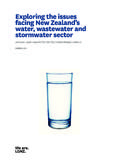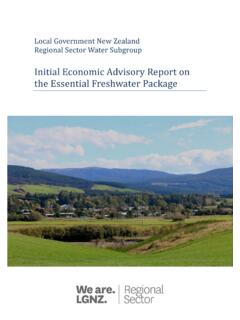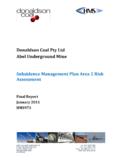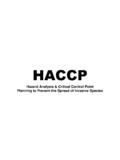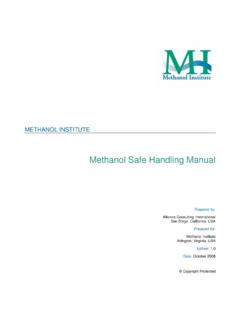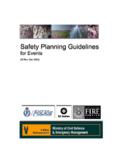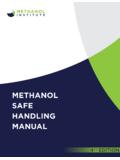Transcription of Managing natural hazard risk in New Zealand – …
1 Managing natural hazard risk in New Zealand towards more resilient communities A think piece for local and central government andothers with a role in Managing natural hazardsOctober 2014 This paper has been prepared by Gerard Willis (Enfocus Ltd). It was commissioned by LGNZ and Regional Councils. The paper identifies why natural hazard management is important in New Zealand ; who the key players are (what roles they have and how they interact); what happens, and does not happen in practice (and why); and what some key challenges are in enhancing overall 1 Summary 31> Introduction 42> Background and methodology 63> The New Zealand hazardscape 84> natural hazards and society 115> The law and policy context for natural hazard management 166> Roles and responsibilities for natural hazard management 227> Discussion and analysis 278> Strengths and weaknesses 339> Gaps and opportunities 3710> Conclusions and recommendations 4911> Appendices Appendix 1 Tsunami heights at increasing return timesxxv 52 Appendix 2a Indicative national risks 53 Appendix 2b Comparison of New Zealand risks and existing criteria 54 Appendix 3 Return period
2 Versus risk based approach to hazard management 55 Appendix 4 Responses to questions on research priorities 57 Glossary and references 591 Managing natural hazard risk in New Zealand towards more resilient communitiesForewordThose of us in local government have always known that Managing natural hazards is important. It was, after all, the raison d tre of catchment boards, a fore-runner of regional there is a lot of good work being done, in the world of contemporary local government most of us also know how easy it is to let natural hazards management drift along. Amongst the many calls on resources for the immediate issues, natural hazards can default to a low priority.
3 This is often aided by strong pressures from some sectors and individuals to create inertia or play down risks , because of perceived adverse consequences of hazard management interventions on specific investments and hazard management also has particular complexities. There are major knowledge gaps between what we need to know and what we actually know to enable sound planning and good decisions. There are also more than the normal alignment gaps due to the multitude of parties involved from both the private and public sectors and multiple individuals, communities and organisations. These often produce major differences between what we think or want people to do and what they actually do.
4 Uncertainties also lead to significant implementation gaps, whereby actions, even when carefully thought to be the right actions, sometimes do not achieve their expected outcomes. natural hazards management is therefore a seriously challenging business, even if accorded a high priority with attendant of recent years both here and overseas, present a timely reminder that our hazardscape does not stand still, our knowledge of hazards and our vulnerability to events are both on the rise and we do need to stand back and take stock of whether we are doing the best we can as councils, the broader public sector, and as a country to manage the risks rationally and sustainably (socially and financially).
5 In the field of natural hazard management local government has extensive experience and expertise more resides in the local government sector than in any local government does not have all the answers and it can t manage risks in isolation. We are part of a bigger picture. Other players, notably central government agencies, have important roles. In meeting this challenge it will be important to strengthen the horizontal relationships with these agencies and avoid slipping further into hierarchical management that has proven counter-productive to resolving hazards (and other natural resource issues) in the paper has been commissioned because we want local and central government to think hard about how we might do better for our communities and how we might collectively take control of the responsibility for doing Zealand seems reasonably well regarded internationally for being conceptually in a good practice space in our overall approach to natural hazards management and perhaps rightly so.
6 We understand the need to apply effort across the continuum from hazard mitigation to adaptation, and across the four Rs from risk reduction, readiness, response and recovery aspects. We also comprehend the need to develop resilience at all levels starting with the individual. These concepts are generally well captured in our laws and organisational mandates. But below that important level of broad understanding and recognition, there are substantial questions that we need to consider about our collective organisational and operational effectiveness. Put simply, do we walk the talk as well as we can or should?Two core ideas dominate natural hazards management: 1.
7 The need for issue and place-specific responses; and 2. the need for integration and collaboration to develop and deliver those effective responses across the many players with a role to play. Yet integration and collaboration are a great deal easier to require than they are to deliver. That is a key are myriad issues this paper takes a helicopter view to progress a behalf of the Steering Group:Kelvin Berryman Manager natural hazards Research Platform, GNSPat Helm Security and Risk Group, Department of Prime Minister and CabinetBryce Davies Senior Manager External Relations, IAGR ichard Smith Manager Science and Education, Earthquake CommissionPeter Kingsbury Principal Advisor, natural ResourcesSteve Markham Policy Manager, Tasman District CouncilClive Manley Civil Defence Emergency Management Director, Auckland CouncilMike Adye Group Manager Asset Management, Hawkes Bay Regional CouncilGary O Meara Chief Operating Officer, Capacity infrastructure ServicesDon Chittock Programme Manager Strategic Programmes.
8 Environment Canterbury Frances Sullivan Principal Policy Advisor, LGNZ. Coincidentally, this paper was being completed as the Local Government Insurance Market Review was released. That review encourages councils to spend more resources on risk profiling, risk management and risk mitigation to improve self-reliance and resilience. This paper is complementary in making some similar suggestions in the way councils manage risks to coincidentally within Central Government, a range of relevant activities are in progress. These include examinations and reviews of core national infrastructure and related community resilience, RMA reforms, national security, civil defence emergency management, and Government funded research systems and priorities.
9 natural hazards management is generally well recognised as a very important consideration for all these inter-related key suggestion in this think piece is for the need for a more strategic collaborative approach to natural hazards management. This idea is elaborated on within the paper. In considering this, it is important to be clear that strategy, as we see it, is emphatically not about producing a large plan, or nationally directed top-down operational blueprint. Rather, strategy is about thoughtful purposeful action. It is about providing a framework for better, more integrated and cohesive decision-making and action at all levels. Strategy is about being as clear as possible about our collective aims and then testing opportunities and synergising capabilities to be as effective as possible.
10 I commend the paper to you and extend my appreciation to the members of the Steering Group who offered their time and expertise to develop this think piece. I also acknowledge those many people who assisted with input to the draft report or who later responded to the circulated draft leading to this final report. I note especially the expertise of Gerard Willis (Enfocus) in pulling the report together. Basil Chamberlain Chief Executive Taranaki Regional Council Managing natural hazard risk in New Zealand towards more resilient communities3 SummaryThis report reviews current arrangements for Managing natural hazards risk in New Zealand . Although it is not premised on a belief that the current system is in a fundamentally poor state, it identifies a range of issues.
